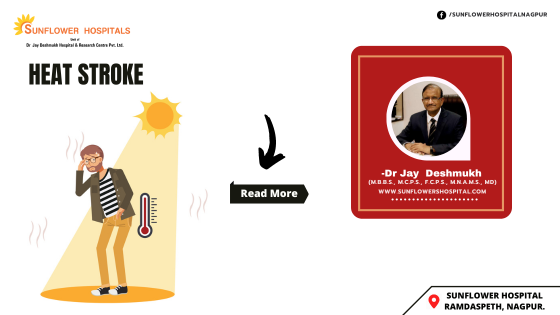What is a heat stroke?
Though recognized for centuries, it was only in 1996 that heat stroke has been recognized as a multi-organ failure with involvement of the lungs, kidneys, heart, liver, brain, and intestines. It is caused by abnormally high environmental temperatures. This leads to thermoregulatory dysfunction, leading to multiple organ damage.
Which group of individuals are suspect?
Those who are constantly exposed to high temperatures such as drivers of autorickshaws, mechanics, self-employed building construction workers, and policemen are susceptible. However, infants and children, and elderly populations are more susceptible. Patients on diuretics, beta-blockers, thyroxine, sedatives, and laxatives are more susceptible. Individuals with long-standing cardiovascular and respiratory diseases, alcohol abuse, and with skin disorders that impair-sweating are more susceptible. Inexperienced sports persons exposed to high environmental temperatures are at risk.
What is the reason for heat stroke?
We have a thermostat in the brain that prevents the rise in body temperature in spite of the high environmental temperature. This is possible by the skin, which cools the body by sweating, dilation of blood vessels, increase in cardiac output, and constriction of blood vessels of the digestive tract. These mechanisms help us to maintain body temperature at 37 degrees centigrade. Excessive body temperature leads to damage to the cells, including mitochondria, and the massive release of inflammatory chemicals known as cytokines. The thermoregulatory apparatus loses its effectiveness and the body temperature rises beyond 40 degrees centigrade.
What are the symptoms of heat stroke?
Core body temperature of more than 90 degrees centigrade, mild confusion, inappropriate behavior, convulsions, and coma are important features. Hot dry skin, absence of sweating, and dehydration are common features. Some may have nausea and vomiting, rapid breathing, and throbbing headaches.
How to prevent heat stroke?
Heat stroke is predictable and preventable. Wear loose-fitting, lightweight clothing as tight clothing would not Global warming is going to increase the incidence of heat stroke. In the last few years, the incidence is rising to alarming degrees. This is entirely due to climate changes due to global warming. Worldwide, the temperature in summer is going to increase, bringing with it greater hardship due to heat stroke and heat exhaustion.
Allow your body to cool properly. Drink plenty of fluids. Staying hydrated allows your body to sweat and maintain a normal body temperature. Never leave anyone in a parked car, as this is a common cause of death in children. Try to schedule your activity outside during cooler parts of the day. In case you have a heart or kidney ailment, be extra careful.
What is the basic treatment?
Heat stroke treatment is basically focused on reducing your body temperature as soon as possible to reduce damage to your brain and other important organs. Immerse yourself in cold water: A bath of cold or ice water is recommended. Evaporation and cooling technology involves sprinkling your body with cold water while warm air is fanned over you. This causes water to evaporate and cool your skin. Wrap yourself in a special cooling blanket. Apply ice packs to your groin, neck, back, and armpits to lower body temperature. Measures to reduce shivering by the use of muscle relaxants are important. Intravenous fluids, oxygen therapy, and ventilator support may become necessary.
What are the basic tests?
A rectal temperature is the best way to assess core body temperature. Special thermometers are available for this measurement. Blood tests to assess kidney function including Sodium and Potassium are done. Check-in for increased acid in the blood is mandatory. Muscle function tests and cardiac assessment is done. All internal organs are systematically assessed, and the treatment is modified.
What are the major complications?
Sudden or delayed death is possible. Severe dehydration, low blood pressure, acute kidney damage, and acute brain and lung damage are common in serious cases. Blood clotting difficulty, respiratory complications, the need for dialysis, and treatment for high potassium levels are important. The changing climatic scenario and unusually high temperature beyond human endurance have introduced a serious medical condition in the form of heat stroke. To prevent this, it is important to effectively implement preventive measures, early detection, and prompt treatment of heat stroke.
Author: Dr Jay Deshmukh
Dr Jay Deshmukh is Chief Physician and Director, Sunflower Hospital, Nagpur Honorary Physician to Honorable Governor of Maharashtra and PondicherryCentral. Dr Jay Deshmukh is an M.B.B.S., M.C.P.S., F.C.P.S., M.N.A.M.S., MD From Internal Medicine – Bombay and New Delhi.


